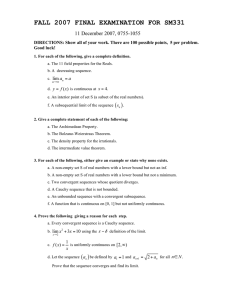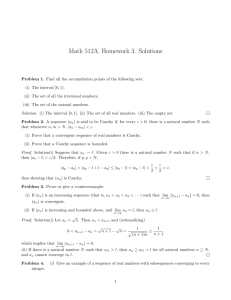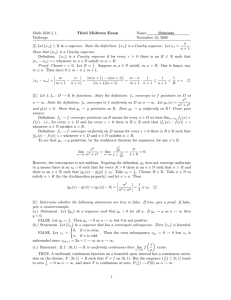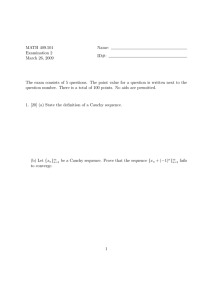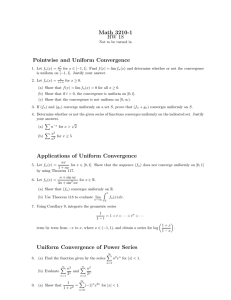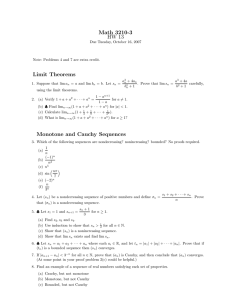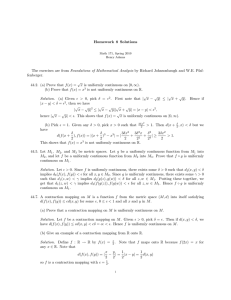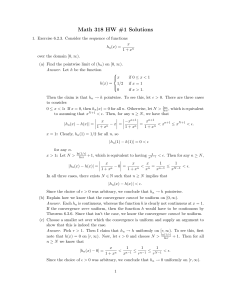Math 3210 § 3. Third Midterm Exam Name: Solutions
advertisement
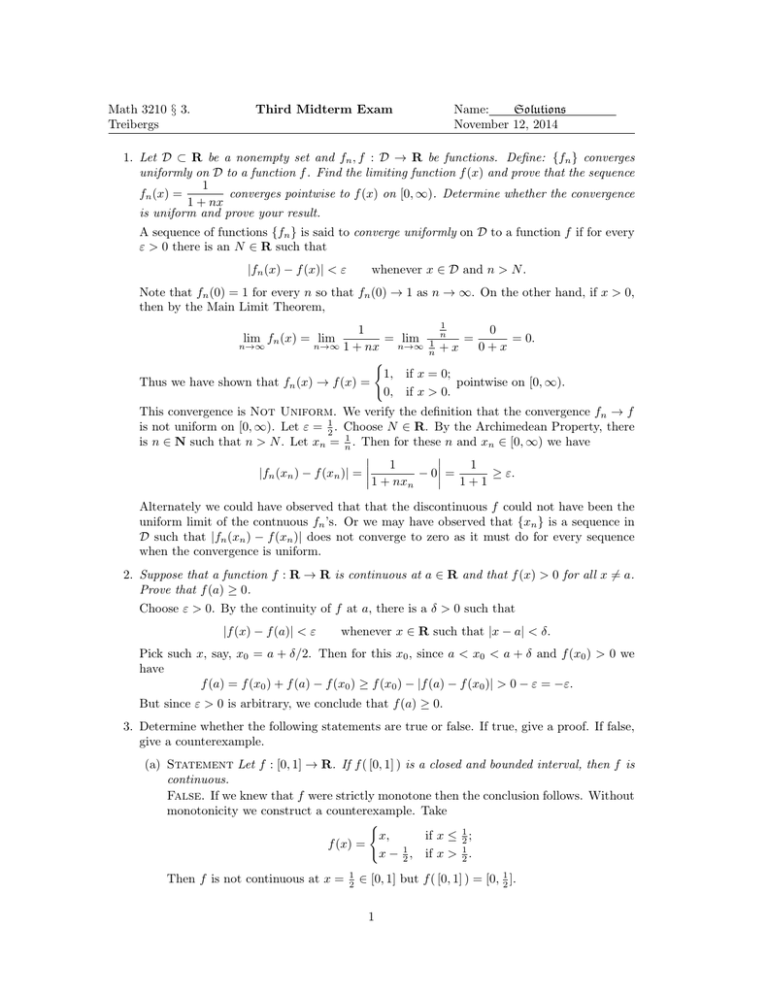
Math 3210 § 3.
Treibergs
Third Midterm Exam
Name:
Solutions
November 12, 2014
1. Let D ⊂ R be a nonempty set and fn , f : D → R be functions. Define: {fn } converges
uniformly on D to a function f . Find the limiting function f (x) and prove that the sequence
1
converges pointwise to f (x) on [0, ∞). Determine whether the convergence
fn (x) =
1 + nx
is uniform and prove your result.
A sequence of functions {fn } is said to converge uniformly on D to a function f if for every
ε > 0 there is an N ∈ R such that
|fn (x) − f (x)| < ε
whenever x ∈ D and n > N .
Note that fn (0) = 1 for every n so that fn (0) → 1 as n → ∞. On the other hand, if x > 0,
then by the Main Limit Theorem,
1
1
0
= lim 1 n =
= 0.
n→∞
n→∞ 1 + nx
n→∞
0
+
x
n +x
(
1, if x = 0;
Thus we have shown that fn (x) → f (x) =
pointwise on [0, ∞).
0, if x > 0.
lim fn (x) = lim
This convergence is Not Uniform. We verify the definition that the convergence fn → f
is not uniform on [0, ∞). Let ε = 21 . Choose N ∈ R. By the Archimedean Property, there
is n ∈ N such that n > N . Let xn = n1 . Then for these n and xn ∈ [0, ∞) we have
1
1
≥ ε.
− 0 =
|fn (xn ) − f (xn )| = 1 + nxn
1+1
Alternately we could have observed that that the discontinuous f could not have been the
uniform limit of the contnuous fn ’s. Or we may have observed that {xn } is a sequence in
D such that |fn (xn ) − f (xn )| does not converge to zero as it must do for every sequence
when the convergence is uniform.
2. Suppose that a function f : R → R is continuous at a ∈ R and that f (x) > 0 for all x 6= a.
Prove that f (a) ≥ 0.
Choose ε > 0. By the continuity of f at a, there is a δ > 0 such that
|f (x) − f (a)| < ε
whenever x ∈ R such that |x − a| < δ.
Pick such x, say, x0 = a + δ/2. Then for this x0 , since a < x0 < a + δ and f (x0 ) > 0 we
have
f (a) = f (x0 ) + f (a) − f (x0 ) ≥ f (x0 ) − |f (a) − f (x0 )| > 0 − ε = −ε.
But since ε > 0 is arbitrary, we conclude that f (a) ≥ 0.
3. Determine whether the following statements are true or false. If true, give a proof. If false,
give a counterexample.
(a) Statement Let f : [0, 1] → R. If f ( [0, 1] ) is a closed and bounded interval, then f is
continuous.
False. If we knew that f were strictly monotone then the conclusion follows. Without
monotonicity we construct a counterexample. Take
(
x,
if x ≤ 21 ;
f (x) =
1
x − 2 , if x > 12 .
Then f is not continuous at x =
1
2
∈ [0, 1] but f ( [0, 1] ) = [0, 12 ].
1
1 + x + x2 + x3
= 2.
1 + x + x2
True. Since f (x) is a rational function whose denominator doesn’t vanish because
(b) Statement There is a point x ∈ R such that f (x) =
1 + x + x2 =
3
+
4
1
+x
2
we know that f is continuous on R. Because f (0) =
2
≥
3
4
1
1+2+4+8
= 1 and f (2) =
=
1
1+2+4
15
> 2 we see that y = 2 is between f (0) and f (2). It follows from the Intermediate
7
Value Theorem that there is c ∈ [0, 2] such that f (c) = 2.
(c) Statement Suppose the real sequence {an } satisfies lim |an+1 − an | = 0.
n→∞
Then {an } is convergent.
√
False. Consider the sequence an = n. Then |an+1 − an | =
√
√ √
√ ( n + 1 − n)( n + 1 + n) √
√
1
√
√
=
= | n + 1 − n| = √
√ → 0
n+1+ n
n+1+ n
as n → ∞, but {an } is not convergent because it is not bounded.
4. Let f : (0, 1) → R be a function. Define: f is uniformly continuous on (0, 1). Using just
x2
the definition, show that f is uniformly continuous on (0, 1) where f (x) =
.
3−x
f : (0, 1) → R is called uniformly continuous if for every ε > 0 there is a δ > 0 such that
|f (x) − f (y)| < ε
whenever x, y ∈ (0, 1) and |x − y| < δ.
4
ε. For any x, y ∈ (0, 1) such that |x − y| < δ we have |x| ≤ 1,
7
|y| ≤ 1, 2 ≤ 3 − x and 2 ≤ 3 − y so that
2
x
y 2 |f (x) − f (y)| = −
3 − x 3 − y
|(3 − y)x2 − (3 − x)y 2 |
=
(3 − x)(3 − y)
2
|3(x − y 2 ) − x2 y + xy 2 |
=
(3 − x)(3 − y)
|3(x + y)(x − y) − xy(x − y)|
=
(3 − x)(3 − y)
|3x + 3y − xy| |x − y|
=
(3 − x)(3 − y)
(3|x| + 3|y| + |x| |y|)
≤
|x − y|
(3 − x)(3 − y)
(3 · 1 + 3 · 1 + 1 · 1)
7
7
≤
|x − y| = |x − y| < δ = ε.
2·2
4
4
Choose ε > 0. Let δ =
2
5. Let {sn } be a real sequence. State the definition: {sn } is a Cauchy Sequence. Using just
the definition, show that {sn } is a Cauchy Sequence, where the sequence of partial sums is
defined for n ∈ N by
n
X
(−2)k
sn =
k!
k=0
{sn } is a Cauchy Sequence if for every ε > 0 there is an N ∈ R such that
|sm − s` | < ε
whenver m, ` > N .
We observe that for k ≥ 2 that we have
| − 2|k
2 2 2 2
2
2 2 2 2
2
2·2
= · · · ··· ≤ · · · ··· =
k!
1 2 3 4
k
1 2 3 3
3
1·2
k−2
k
9 2
2
=
.
3
2 3
To prove that the partial sums are a Cauchy Sequence, choose ε > 0. Let
(
)
2ε
log 27
−1 .
N = max 2,
log 23
For any m, ` ∈ N such that m, ` > N we have either m = ` in which case |sm − s` | = 0 < ε.
Or we have m 6= `. By swapping the names if necessary, we may assume that m > `. Then
since N ≥ 2 by using the triangle inequality and the observation
m
`
X (−2)k X
(−2)k |sm − s` | = −
k!
k! k=0
k=0
m
X
(−2)k =
k! k=`+1
m
X
| − 2|k
k!
k=`+1
k
m
X
9 2
≤
2 3
≤
k=`+1
9
=
2
m k
X
2
` k
X
2
!
−
3
3
k=0
m+1
`+1 !
1 − 32
9 1 − 23
=
−
2
1 − 23
1 − 23
m+1 !
2 `+1
− 23
9
3
=
2
1 − 32
`+1
N +1
27 2
27 2
≤
<
≤ ε.
2 3
2 3
k=0
3
